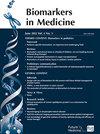Insights into the baseline blood pH homeostasis at admission and the risk of in-hospital mortality in COVID-19 patients.
IF 1.9
4区 医学
Q3 MEDICINE, RESEARCH & EXPERIMENTAL
引用次数: 0
Abstract
Aim: A laboratory finding in critically ill COVID-19 patients is blood academia (pH <7.35). We investigated its cause in connection with the admission baseline blood pH homeostasis.Patients & methods: We retrospectively monitored the baseline blood pH homeostasis of 1215 COVID-19 patients who were admitted with pneumonia using data-driven knowledge. Two categories of patients were identified: non-survivors (107) and survivors (1108).Results: Non-survivors showed greater levels of lactate and lower blood pH, saturation, and partial pressure of oxygen than survivors. A bivariate Spearman's correlation matrix showed that the [HCO3-]/pCO2 and pCO2 of non-survivors exhibited an unmatched connection, but not in the survivor group. When comparing non-survivors to survivors, the dendrograms derived from the bivariate comparison matrix showed differences in gasometry parameters like blood pH, [HCO3-]/pCO2 ratio, anion gap and pO2.Conclusion: The little variations in the gasometry readings between survivors and non-survivors upon admission suggested abnormal changes in the complementary renal and respiratory systems that bring blood pH back to normal. In advanced COVID-19, modest blood acid-base imbalances could become blood acidemia if these compensatory strategies were overused. Data-driven monitoring of acid-base parameters may help predict abnormal blood pH and the advancement of metabolic acidemia before it is too late.洞察 COVID-19 患者入院时的血液 pH 平衡基线和院内死亡风险。
目的:COVID-19重症患者的一个实验室发现是血液pH值异常(pH值<7.35)。患者和方法:我们对 1215 名 COVID-19 重症患者进行了回顾性监测:我们利用数据驱动知识,对 1215 名因肺炎入院的 COVID-19 患者的基线血液 pH 平衡进行了回顾性监测。结果:非存活患者的血液pH平衡水平高于存活患者,而存活患者的血液pH平衡水平低于非存活患者:结果:与幸存者相比,非幸存者的乳酸水平更高,血液 pH 值、饱和度和氧分压更低。双变量斯皮尔曼相关矩阵显示,非幸存者的[HCO3-]/pCO2 和 pCO2 显示出不匹配的联系,而幸存者组则没有。将非幸存者与幸存者进行比较时,从双变量比较矩阵得出的树枝图显示了血液 pH 值、[HCO3-]/pCO2 比值、阴离子间隙和 pO2 等气体测量参数的差异:幸存者和非幸存者入院时的气体测量读数差异很小,这表明肾脏和呼吸系统的互补性发生了异常变化,从而使血液 pH 值恢复正常。在晚期 COVID-19 中,如果过度使用这些代偿策略,轻微的血液酸碱失衡可能会变成血液酸血症。数据驱动的酸碱参数监测有助于预测血液 pH 值异常和代谢性酸血症的进展,以免为时过晚。
本文章由计算机程序翻译,如有差异,请以英文原文为准。
求助全文
约1分钟内获得全文
求助全文
来源期刊

Biomarkers in medicine
医学-医学:研究与实验
CiteScore
3.80
自引率
4.50%
发文量
86
审稿时长
6-12 weeks
期刊介绍:
Biomarkers are physical, functional or biochemical indicators of physiological or disease processes. These key indicators can provide vital information in determining disease prognosis, in predicting of response to therapies, adverse events and drug interactions, and in establishing baseline risk. The explosion of interest in biomarker research is driving the development of new predictive, diagnostic and prognostic products in modern medical practice, and biomarkers are also playing an increasingly important role in the discovery and development of new drugs. For the full utility of biomarkers to be realized, we require greater understanding of disease mechanisms, and the interplay between disease mechanisms, therapeutic interventions and the proposed biomarkers. However, in attempting to evaluate the pros and cons of biomarkers systematically, we are moving into new, challenging territory.
Biomarkers in Medicine (ISSN 1752-0363) is a peer-reviewed, rapid publication journal delivering commentary and analysis on the advances in our understanding of biomarkers and their potential and actual applications in medicine. The journal facilitates translation of our research knowledge into the clinic to increase the effectiveness of medical practice.
As the scientific rationale and regulatory acceptance for biomarkers in medicine and in drug development become more fully established, Biomarkers in Medicine provides the platform for all players in this increasingly vital area to communicate and debate all issues relating to the potential utility and applications.
Each issue includes a diversity of content to provide rounded coverage for the research professional. Articles include Guest Editorials, Interviews, Reviews, Research Articles, Perspectives, Priority Paper Evaluations, Special Reports, Case Reports, Conference Reports and Company Profiles. Review coverage is divided into themed sections according to area of therapeutic utility with some issues including themed sections on an area of topical interest.
Biomarkers in Medicine provides a platform for commentary and debate for all professionals with an interest in the identification of biomarkers, elucidation of their role and formalization and approval of their application in modern medicine. The audience for Biomarkers in Medicine includes academic and industrial researchers, clinicians, pathologists, clinical chemists and regulatory professionals.
 求助内容:
求助内容: 应助结果提醒方式:
应助结果提醒方式:


